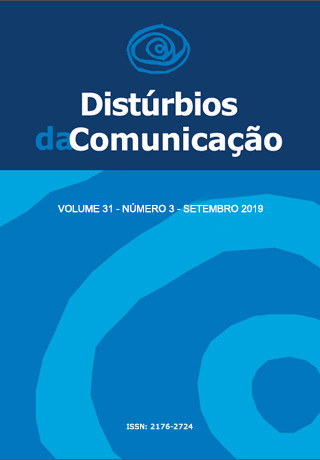Características del sueño de los niños respiradores orales encaminados para la realización de adenoidectomía y/o amigdalectomí
DOI:
https://doi.org/10.23925/2176-2724.2019v31i3p493-499Palabras clave:
Sueño, Respiración por la Boca, Tonsilectomía, Adenoidectomía.Resumen
Introducción: La respiración oral acarrea diversas modificaciones en la vida de los niños siendo una de ellas las alteraciones en la calidad del sueño pudiendo tener impacto en el desarrollo infantil. Objetivo: Comprender las características del sueño de niños con diagnóstico de respiración oral encaminadas para la realización de cirugías de adenoidectomía y/o amigdalectomía prescritas por el médico otorrinolaringólogo, a partir de las informaciones de la familia y de los propios niños. Método: estudio observacional, analítico, transversal y cuantitativo, realizado con 100 niños de ambos sexos, con rango de edad entre cinco y 12 años, divididos en dos grupos, siendo 50 niños con respiración oral (GE) y 50 niños sin diagnóstico de cambio respiratorio (GC). La evaluación se basó em el protocolo MBGR, la clasificación de Mallampati. Después de la recolección, los datos fueron tabulados y analizados estadísticamente de las variables queja, calidad y características del sueño y clasificación de Mallampati. Resultados: Los padres y/o tutores no mencionaron espontáneamente información relacionada con el sueño. Cuando se indagó sobre la calidad del sueño hubo predominio de síntomas para el GE. Las principales quejas relacionadas con el sueño fueron ronquidos, sialorrea, agitación, boca seca, boca abierta, sueño fragmentado, con mayor ocurrencia para el GE. En cuanto a la clasificación de Mallampati hubo predominio de las clases II y III para el GE y clase I para el GC. Conclusión: Los niños con respiración oral tienen un mayor número de quejas reportadas por los padres / tutores con respecto a la calidad del sueño en comparación con los niños con respiración nasal.Descargas
Descargas
Publicado
Número
Sección
Licencia
Derechos de autor 2019 Tamara Borox Guimarães, Jaqueline Portella Buaski, Maria Fernanda Bagarollo, Ana Paula Dassie-Leite, Gilsane Raquel Czlusniak, Bruno Leonardo Freire de Alencar

Esta obra está bajo una licencia internacional Creative Commons Atribución 4.0.









